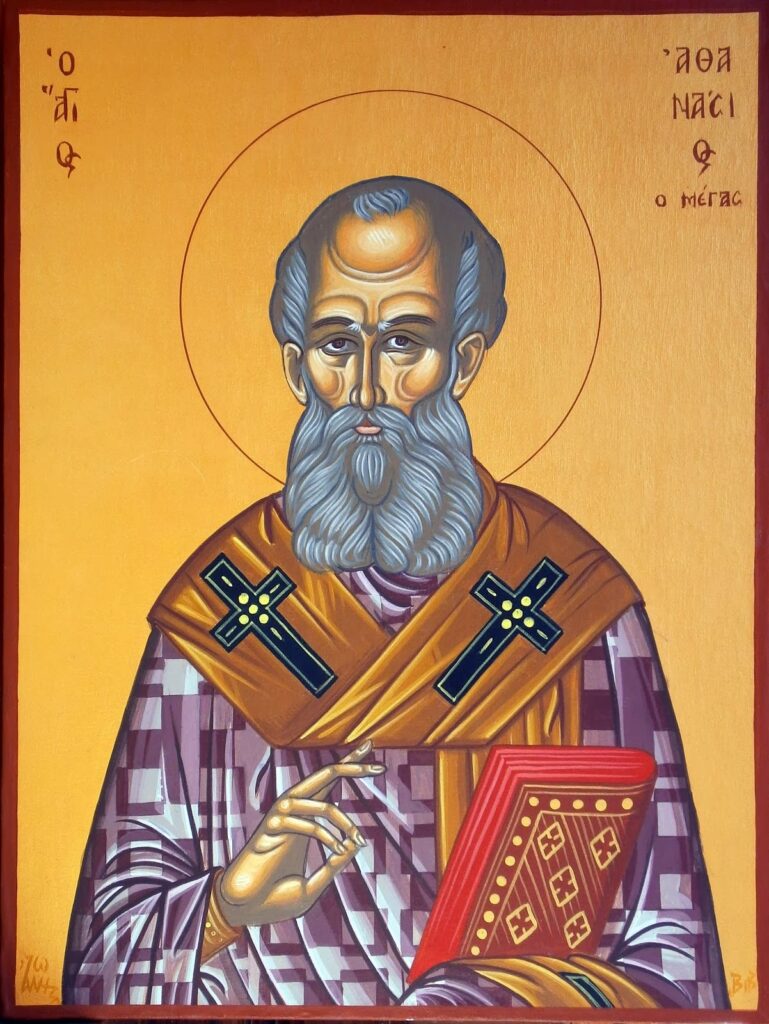

St Athanasius, Defender of the Divinity of Christ
St. Athanasius was bishop of Alexandria, theologian, writer, Egyptian national leader and defender of Christian orthodoxy.
Born into a Christian family sometime in the mid 290s, Athanasius was well educated in his hometown of Alexandria. He was ordained a deacon in 318 AD. Already a recognized theologian before the age of 30, he was soon appointed secretary to Bishop Alexander of Alexandria.
In 323, Arius, a priest of the diocese, came up with his theory that Jesus was not divine, but created in time. Many members of the clergy quickly adopted his theory. It got out of hand so quickly that the Arian heresy was on the docket for the Council of Nicea only two years later, ordered by Emperor Constantine. This is why the Nicene Creed was written. But this did not stop Arius. He was banished from Alexandria and taught his heresy to many in Syria and beyond. In the meantime, Bishop Melitus of Upper Egypt was not forgiving of the people who had reverted to pagan practices while avoiding persecution in previous years. He was so hard on the reverts that he was deemed schismatic. The Council at Nicea worked out plans to reunify his group with the Church. Melitus backed out of the deal.
Bishop Alexander died in 328 and Athanasius was unanimously elected his successor. He immediately had two major enemies to deal with. Before it got bad, the new bishop traveled all over the diocese to meet his priests. He spent time with the Coptic monks in Upper Egypt and the leader of communal monasticism, St. Pachomius. This would be a great help, later.
In 335, a gathering of bishops in Tyre debated the Meletian situation. Athanasius refuted specific charges of mistreatment against Arians and Meletians to no end. Both parties were called to meet with Constantine the next year. Without a formal trial, Athanasius was accused of threatening to interfere with the grain supply from Egypt. Constantine quickly banished him to Trier, a village on the Rhine River in Germany. When Constantine died in 337, Athanasius returned to Alexandria. But not for long. The empire was split in two, each half run by a son of the dead emperor. Costantius, the pro-Arian Eastern emperor, ordered the bishop back into exile within a year. But Athanasius took refuge in Rome under the protection of Constans, the pro-orthodox Western emperor.
The new bishop of Alexandria, Gregory, was Arian. The Arians were quickly very political. Athanasius could only speak to his flock by letter. Pope Julius I tried and failed to lift the sentence. A general council at Sofia in 343 tried to lift it. Western and Egyptian bishops accepted the decisions. But the Eastern bishops would not.
Three years later, Constans secured Athanasius’ return to Egypt and was welcomed home as a hero. For several years, there was peace in the diocese and Athanasiu wrote “Apology Against Arians”.
In 350, Constans died and Constantius became the sole emperor. Civil war ensued. Constantius, who had been neutral, reverted to his pro-Arian stance and proclaimed Athanasius banished again. As things go slowly when communication is bad, it took a while for word to get around. In 356, all sorts of trumped-up accusations and political charges had been invented. The Arian soldiers tried to arrest him during liturgical services.
Athanasius escaped and made his way to the Coptic monasteries of Upper Egypt where he was kept safe. During his several years there, the good bishop wrote his opus “Orations Against Arians”, a work quoted even today. He heard of the persecutions of the orthodox Christians by Bishop George of Alexandria. He could do nothing for his people.
In 360, Constantius died. Bishop George was murdered the following year. Athanasius returned to his rightful position. He called for the Synod of Alexandria. At the synod, Athanasius appealed for unity to understand that the same Faith could have different terminology. This would help to explain the doctrine of the Trinity, later.
Apparently, he had not gone far enough for the new emperor, Julian the Apostate. He ordered Athanasius to leave Alexandria. Again! The bishop returned to his friends, the Coptic monks. When Julian died in 363, Emperor Jovian ordered Athanasius returned, only to have his exile re-ordered by the new pro-Arian emperor, Valens eight months later. This time, Athanasius only moved to the suburbs of Alexandria. The emperor was persuaded to change his mind after four months.
In the last decade of his life, Athanasius was blessed with more peace than not. He died May 2, 373, almost 80 years old.
St. Athanasius’ feast day is May 2. He is considered a Doctor of the Church.

Recent Comments